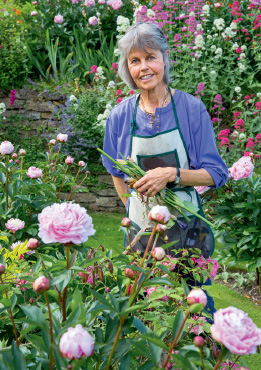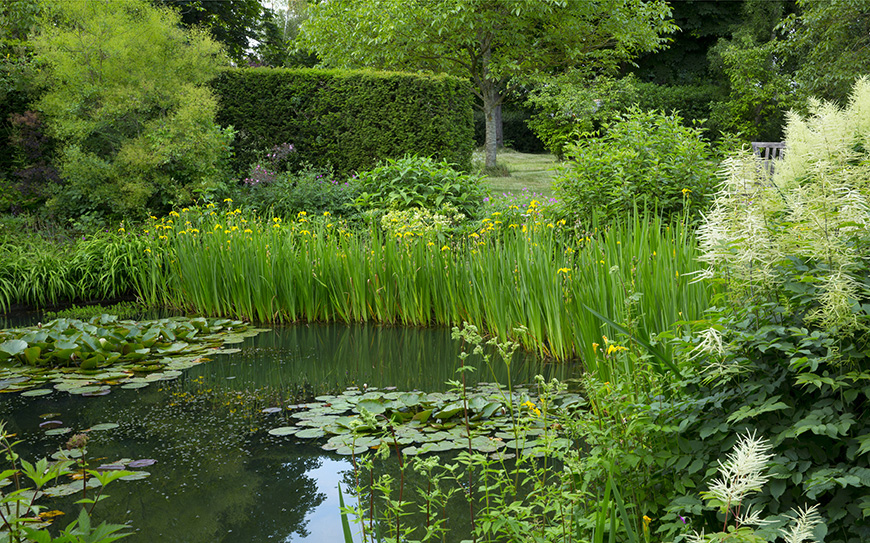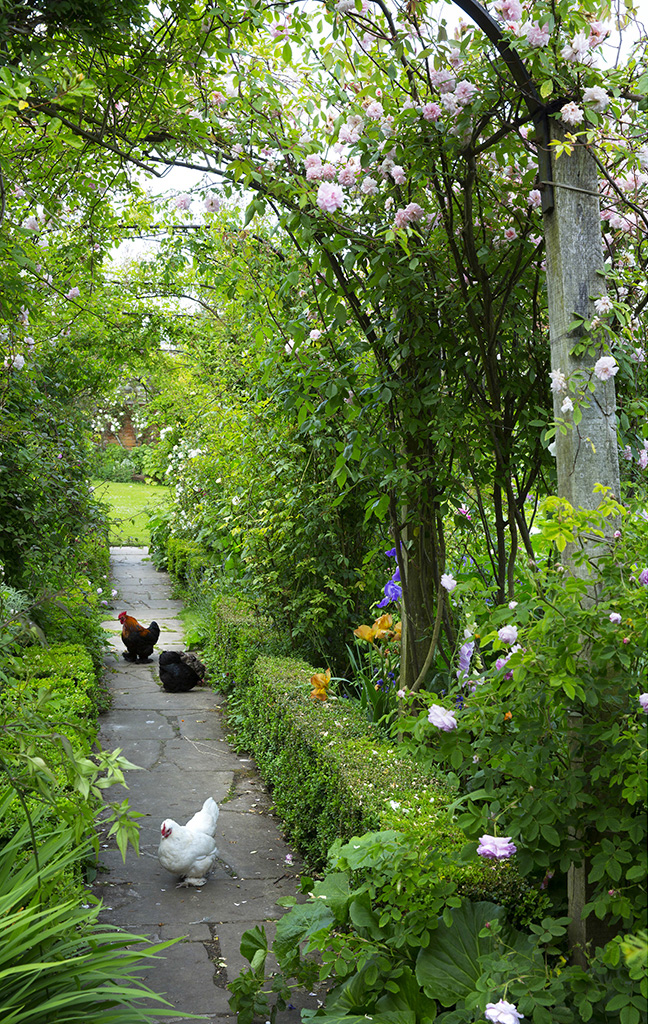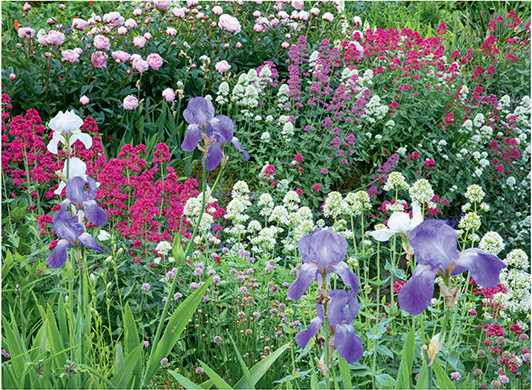
ROSAMUND WALLINGER
How Upton Grey Manor was brought back to life

Upton Grey is one of those English villages untouched by time which remains steeped in tradition. It is perhaps fitting, therefore, that it was here, abutting the church and surrounded by trees, that an English garden masterpiece managed to remain hidden from sight for several decades. This garden which had been created during the heyday of English gardens was reawakened from its long slumbers by a remarkable woman named Rosamund Wallinger. The garden was, in fact, low on the list of the Wallingers’ priorities when they bought Upton Grey. What they were mainly looking for was a house in the country within commuting distance of London where they could park their car in peace, as John Wallinger had become tired of the habitual evening hunt for a parking space at the end of a long working day. To begin with, his wife Rosamund thought it was all a bit of a hare-brained scheme that would eventually be forgotten. However, thirty years on, Rosamund Wallinger, who once had only a tiny garden in London to care for and had no interest either in plants or gardens, is now usually found in the middle of a flower bed with a pair of secateurs in hand.
ACCIDENTAL DISCOVERY
This perfect image of an English lady gardener did not develop overnight. Nor was it ever intended: it was all the fault of the house, Upton Grey Manor, and the result of a brief, almost incidental entry in records discovered in the library of the Royal Institute of British Architects. These documented that the house was a listed building and that the garden was believed to have been designed by Gertrude Jekyll (1843–1932). With no real idea of what she was letting herself in for, Rosamund Wallinger immersed herself in the world of garden archaeology. Her investigations were to involve years of detective work, frustration, determination and back-breaking graft, all of which were ultimately rewarded by immense pleasure. Rosamund Wallinger succeeded in restoring a garden designed by the most significant female gardener in the history of English gardens. Gertrude Jekyll designed the garden from 1908–09 as an extension to the house which had been built, or rather rebuilt, by Ernest Newton for publisher Charles Holme (1848–1923).
The garden of Upton Grey Manor in Hampshire, not far from Basingstoke, is exquisite. It has been restored to its original state right down to the last shrub. Today, it represents the story of two women, the expert and the novice. Rosamund Wallinger recorded her journey of discovery – which is the only way to describe the way she tackled this garden project – in two books: in 2000, she published Gertrude Jekyll’s Lost Garden and in 2013 she produced her most recent work, Gertrude Jekyll: Her Art Restored at Upton Grey. Both volumes are in the form of an album and document the step-by-step process of how the garden was revealed and developed. When the Wallingers first viewed the house in 1983, their attention was focused on the historic building. The 2 hectares/5 acres of garden – as far as it could even be described as a garden – was a wilderness, an unkempt jungle of blackberry bushes, shrubs and overhanging trees. A year later, the new owners moved into the house, itself sorely in need of renovation, and began doing some research on the garden, scouring libraries to find clues as to its original state. Their research led them to the University of California, which holds and administers the archives of Beatrix Farrell, known as the Reef Point Collection. This collector, herself an important landscape architect, had purchased all the plans, photographs and albums belonging to Gertrude Jekyll’s heirs and amalgamated them for posterity. Part of this treasure included a total of nineteen garden plans for Upton Grey Manor, a complete set of designs which contained all the relevant information, from the measurement plan to the meticulously drawn planting plans, as well as a detailed picture of how the garden eventually looked. In common with other designers of her time, Gertrude Jekyll always kept the originals of her designs, providing her clients with a copy.
PURE JEKYLL
Upton Grey is just one of more than 300 gardens which Jekyll designed in her lifetime. However, it occupies a special position in her life’s work: although many gardens claim to be Jekyll gardens, many of them were only partially designed by her. Others have undergone such radical changes over the years that the true art of this outstanding garden designer is no longer in evidence.

Romantic and inviting: the entrance to the Wild Garden.

The Pond Garden with its naturalistic drifts of Iris pseudacorus and white astilbe is in complete contrast to the Formal Garden.
Anyone who believes that creativity is the preserve of youth will be obliged to revise this opinion on seeing Upton Grey. Miss Jekyll was sixty-five when she accepted the commission. While others were already enjoying retirement, she was at the peak of her design career, a line of work that she wandered into by chance. In 1891, a German eye specialist in Wiesbaden, by the name of Pagenstecher, strongly advised her to give up painting and embroidery if she wanted to preserve her sight. She was just fifty-two at the time, a spinster who lived for her art. She was a progressive lady, cultured, well-educated and well-travelled, from a good family and financially secure. Although she lived with her mother, she had a free hand in developing their garden at Munstead in Surrey in her own style. It soon began to attract leading figures from the gardening world. In 1882, when the constant stream of visitors became too much for her mother, Gertrude acquired a plot of adjacent land measuring about six hectares/15 acres on which she created the framework for Munstead Wood Garden. It was here that Gertrude wrote her books and lived until her death at the age of eighty-nine. Another milestone in her life was her meeting in 1889 with Edwin Lutyens (1869–1944), who was then a young man on the threshold of his career as an architect. Their first meeting over afternoon tea was a formal affair. Their second encounter, an invitation to Jekyll’s home, left a much stronger impression, as described in Francis Jekyll’s book Gertrude Jekyll: A Memoir:
‘Genial and chatty, dressed in a short blue skirt that hardly hid her ankles and in boots that were made famous by W. Nicholson’s painting; a blue apron with huge kangaroo-like pockets full of gardening things; a blue-striped pleated blouse with narrow sleeves tight around her round wrists, just giving her small and distinctive hands freedom to move.’
It marked the beginning of an exceptional partnership, which was to influence the appearance of country houses all over the British Isles. Anyone occupying a Lutyens house with a Jekyll garden had arrived, socially speaking. The pair also developed the ideal of a perfect English country house with long roofs, chimneys, leaded windows, surrounded by a romantic, flower-filled garden, lawned areas for tennis and croquet, room for garden furniture and serving afternoon tea and providing a plentiful supply of cut flowers for the house. Despite looking old on the outside, it had to be comfortable or even ‘cottagey’ on the inside. No cost was spared to achieve what was then considered a modern lifestyle. The English country house style was born and the vision of living in a cottage became the dream of the growing population of middle classes.
Popular and hard-working as she was, Jekyll designed about ten gardens per year. This was a considerable number considering that everything had to be drawn by hand. In addition, she also wrote newspaper articles and books, which are nowadays regarded as standard references. She set up a nursery for herbaceous plants to supply her architects with the appropriate stock and displayed keen business acumen. Rosamund Wallinger has copies of bills from the Munstead Wood nursery, which include handwritten notes itemizing the quantities, prices and noting whether the goods had been delivered.
GARDENS AS ART
Gertrude Jekyll was an authority on everything to do with gardening and a pioneer of gardens as an art form. However, the 1950s ushered in a new passion for modernism and Gertrude Jekyll became less fashionable. Although her name was still familiar and well respected in professional circles, it was not widely known by the general public. It is not surprising, therefore, that when Rosamund Wallinger came across the name Jekyll, she had no idea who she was dealing with. As she herself admits, she was purely concerned with producing a faithful reconstruction: ‘This garden is a recreation of Jekyll’s art, not mine.’
When Rosamund took stock of the garden at Upton Grey, Jekyll’s former design was a wilderness. It had to be cleared, dug over and cut back without disturbing the basic elements. Bit by bit, natural stone walls, the outlines of beds, remains of old rose stocks all began to emerge. With the aid of plans, which were kindly copied and made available by the Reef Point Collection, the garden slowly revealed itself. The preparation work for this major project was considerable and not to be underestimated. Before any planting could even begin, walls had to be repaired. The project was soon being talked about and gained the attention of the Hampshire Gardens Trust while some valuable tips were offered by experts including Richard Bisgrove and Penelope Hobhouse who visited the building site – no one could describe it as a garden at this stage. Without interfering, they inspired and encouraged Rosamund, an approach which this novice gardener greatly appreciated then as she does now. Consequently, she was able to work at her own pace – a factor which was crucial to her success since despite being in possession of the planting blueprints, this by no means meant that she could get started immediately. The plans first had to be decoded since Gertrude Jekyll’s handwriting was, like her embroidery, meticulous and fine. Thus, Rosamund Wallinger, in addition to all her other newly acquired skills, has become a true expert on Jekyll’s handwriting

Pergolas, festooned with roses, such as ‘Cécile Brünner’ shown here, are true hallmarks of a Jekyll garden. The bantam hens are Rosamund’s addition and have the run of the entire garden.

Working from the original planting plans, Rosamund Wallinger was able to restock the flower beds. In the example shown here, she used bearded iris (Iris germanica) and peonies such as Paeonia lactiflora ‘Sarah Bernhardt’.
RAISING FROM SEED
Another challenge was to acquire the plants. Given the quantities required, a large proportion had to be raised from seed, a further steep learning curve for a woman who had started with no basic gardening knowledge. In the process, Rosamund Wallinger has become extremely knowledgeable about sourcing historic plants and constructing pergolas and supports for cascading roses. She studied old photographs made available by former owners of the house and gradually, one bed at a time, the garden has re-emerged. If the garden had been restored by a professional, it would probably have turned out a bit too formal as it would have taken shape too quickly. The finer details and the character of the setting, both of which define today’s garden, would have been lost. Furthermore, it would have been difficult to withstand the temptation to ‘improve on’ the blueprint. Rosamund Wallinger, on the other hand, followed Gertrude Jekyll’s instructions to the letter, not only studying the plans and plant lists but also reading books on the subject in order to gain a better insight into the working environment of her role model.

Each area has a different theme, from the Rose Garden on the right, to the diagonal line of the herbaceous border and Rosamund’s spectacular ‘parking lot for plants’, which can be glimpsed behind the yew hedge.
IN PROPORTION
Gertrude Jekyll’s garden at Upton Grey Manor, reawakened by Rosamund Wallinger, is a work of art. It is compact, homely and manageable – an adjective not normally associated with Jekyll’s gardens. There is a certain logic which runs through the entire garden area. The periphery of the garden is informal and natural, becoming more formal towards the house. The plans show that Jekyll designed the garden layout without the help of an architect. Upton Grey Manor provides the proof, if needed, to understand why Gertrude Jekyll’s designs were so popular in her lifetime. The garden is fresh, alive and absolutely perfect in its proportions. There are neither endless stretches of ground cover nor flights of steps competing for attention. The greenery and the plants have the final word. Gertrude Jekyll is known for her masterly use of herbaceous beds and her delicately balanced colour combinations. In Upton Grey, however, it is clear that these are just a small part of her contribution to garden art while rose gardens and so-called wild gardens are an equally important element of her repertoire.
The garden is divided into formal and informal areas. Both parts are distinctly different in character yet retain elements common to both, the sense of continuity is largely achieved using roses. The flower-filled Formal Garden with its Rose Garden, bowling green, tennis court and herbaceous beds unfolds in terraces at the rear of the house. In front of the house, parallel to the driveway and barely noticeable at first glance, is the Wild Garden, a long rectangular area, almost as large as the Formal Garden. Here, too, the ground is landscaped on different levels. Whereas these levels are retained in the Formal Garden by natural stone supporting walls, the wild area incorporates a slight rise that slopes gently away. These slopes are planted with drifts of daffodils which, along with other wild flowers, are visible from the house as a gentle shimmer of colour in spring. The roses emerge gradually, clusters of small buds which make excellent companions to the lilac and other flowering shrubs. Groups of shrub and rambler roses such as ‘The Garland’, Rosa virginiana and ‘Blush Rambler’ are modest focal points, as Gertrude Jekyll suggests in her book Wood and Garden:
‘I am strongly for treating garden and wooded ground in a pictorial way, mainly with large effects, and in the second place, with lesser beautiful incidents, and for so arranging plants and trees and grassy spaces that they look happy and at home, and make no parade of conscious effort.’
In accordance with these sentiments, the pond is situated in a secluded spot, its banks surrounded by plants and hidden from view: a place to retreat to after the splendour and show of the Formal Garden.
CHOREOGRAPHED COLOUR
By way of contrast, the Formal Garden is a riot. From May to September it produces a choreographed sequence of wonderful blooms which appear to be entirely visible from the terrace. It is only on closer inspection, however, that one becomes aware of the large number of hidden surprises in the form of all kinds of details, which reflect the careful thought that has gone into planting each area, from the smallest flower bed to a run of natural stone walls. Although the design of the beds and division of space is formal, the planting is informal and varied, giving a certain picturesque quality to the overall effect. A concept of this scale requires enormous experience. The strength of Jekyll’s planting lies in her colour schemes which are specially chosen to complement the gentle, milky light of a Hampshire summer. This garden is also the most successful example of how best to integrate a tennis court into a garden. Boasting a lawn that would not look out of place at Wimbledon and, like the rest of the Formal Garden, surrounded by yew hedging, the function of this area is not immediately obvious. Is this thanks to the lawn, which provides a calm, neutral background or to the rose pergola in the middle? Set back into a niche in the hedge and covered with a profusion of roses, including ‘Paul’s Himalayan Musk’, this charming pergola is an eye-catching attraction.
PROFUSION AND TRANQUILITY
What makes this garden so charming is the alternate mix of profusion and tranquility. The geometrical beds of the Rose Garden, cut out of a lawned area, not only contain roses such as ‘Madame Caroline Testout’ and ‘Killarney’, but are also bordered by peonies (Paeonia officinalis ‘Lize van Veen’), and lilies (Lilium regale), as well as lambs’ tongue (Stachys byzantina). Slightly raised on the surrounding, almost horseshoe-shaped area are the herbaceous beds, also called mixed borders. These are numbered as are all the beds shown on the plan. They contain daylilies, asters, lupins and many others, too many to list individually. Dahlias, which Gertrude Jekyll liked to use as fillers to disguise faded plants, can be seen during the summer months along with the annuals Nigella damascena and cosmos. The diversity is impressive and it must be borne in mind that all this has been accomplished by a woman who is entirely self-taught. There is a gardener, as well as occasional part-time staff who work in the garden, but only as helpers. Rosamund Wallinger carries out the bulk of the work herself.

The Rose Garden is situated at the heart of the garden, a testimony to Miss Jekyll’s planning and Rosamund’s work.

From the upstairs windows of the main house, one can see how the garden is skilfully divided into different areas.

Skilful placing of green-leaved shrubs is particularly useful for bringing out the luminescent, pale colours of the roses, peonies and lilies.
The knowledge and skills required to maintain a Jekyll garden, let alone plant it, are considerable. It is only by looking at the photographs displayed in the conservatory and comparing them with how the garden looks today that one can fully appreciate the incredible achievements of this slim, delicate woman. Rosamund’s husband, who was essentially the root cause for all this, works in the background, supporting his wife, sacrificing his weekends and taking an energetic part in the clearance operations. Just how far Rosamund Wallinger has come in terms of gardening is evident from the Kitchen Garden which she has planted at the side of the house. Here, parallel to the Formal Garden and, from an outsider’s perspective, an integral part of Gertrude Jekyll’s overall composition, is where her stock plants live. Right at the end are also a few vegetables and kitchen herbs for daily use. This area, with Jekyll-style double herbaceous borders, which lead to cascading rose arbours with an apple orchard beyond, could easily have been designed by Gertrude Jekyll as the beds clearly echo the hallmarks of her style of planting. It was in fact designed by her longstanding pupil Rosamund Wallinger.
VISUAL DELIGHT
Jekyll’s gardens are a visual delight, often characterized by tiny, yet crucial details. While restoring the garden, a decision was made to dispense with a little supporting wall, barely 30cm/12in high, between the tennis court and bowling green, and to allow the ground to slope down instead. At first Rosamund Wallinger herself did not realize the importance of this tiny wall until she saw the cover of her first book. The slope was certainly in place but the crisp outline, the dotting of the ‘i’, was missing and the composition lacked balance. This finishing touch has now been reinstated. Delicate and unobtrusive, a narrow bed at the base of the little wall now not only outlines the lawn area but also defines the flowing descent of the terraces and – even more importantly – creates a sense of depth.
The gardens of Upton Grey Manor are an inspiration. With Rosamund Wallinger as a role model and Gertrude Jekyll as a teacher, it is possible with enough determination for any one of us to create an English garden masterpiece on our doorstep.
GUIDING PRINCIPLES
|
‘The love of gardening is a seed that once sown never dies, but grows and grows to an enduring and ever-increasing source of happiness.’ Gertrude Jekyll, Wood and Garden (1899). |
|
‘Let no one be discouraged by the thought of how much there is to learn.’ Apposite words from the introduction to Wood and Garden, which Rosamund Wallinger took to heart. Intensive research and preparation cannot be avoided when working on historical projects. |
|
If an original plant is not available, one must improvise. |
|
The value of annuals as fillers in a flower bed should not be underestimated. One of the best old-fashioned species in this respect is the much-neglected snapdragon (Antirrhinum). |
SIGNATURE PLANTS
|
Peonies such as Paeonia lactiflora ‘Sarah Bernhardt’ and P. officinalis |
|
Delphiniums in the herbaceous borders and in the ‘plant parking lot’ bed; here, Delphinium elatum. |
|
Irises (Iris pallida and I. germanica). Almost all the varieties mentioned by Gertrude Jekyll on her plan have now been lost to cultivation. Consequently, modern equivalents such as ‘Sable’ and ‘Golden Harvest’ have been used instead. More modest varieties, such as Iris pseudacorus have been used in the Wild Garden. |
|
Rambler roses, such as ‘Blush Noisette’ and climbing ‘Blush Rambler’ (introduced in 1903). Rosamund believes that Jekyll’s favourite was ‘The Garland’, a rose which is also one of her own favourites. |
|
Fragrant daylily (Hemerocallis dumortieri) with a long flowering season. Bergenia cordifolia, frequently used by Miss Jekyll as an edging plant for flower beds. |
